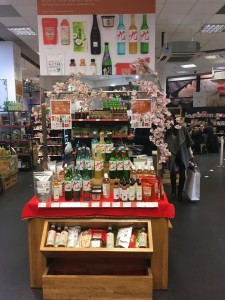Maniwa City in Okayama Prefecture has been particularly active in place branding and local goods promotion in 2017, with two events taking place in London at the Daiwa Foundation and the Japan Centre, London’s popular food hall off Piccadilly, promoting produce from the area as well as local arts and crafts.There were tastings of green tea, sake and miso from Maniwa City at the first event highlighting highlighting the arts and crafts of the Hiruzen Plateau in Maniwa City, which is visited by over two million tourists per year, at Daiwa Foundation on 10 March. Gobara, a small village hidden away in one of the plateau’s corners, is home to Gobara lacquerware, a type of lacquerware that is made for everyday use. In this event, local artisan Kunimitsu Takatsuki explained about the history and techniques of this unique urushi.
Gobara lacquerware uses woodgrain from the chestnut trees native to the Hiruzen Plateau. The natural grain of the chestnut wood is finished with the natural varnish of lacquer trees, creating a firm, long-lasting coating. This is completed with a high-quality gold-inlaid lacquerware technique. Unusually, Gobara lacquerware uses a unique method of making woodgrain by grinding raw timber – a special process not found in any other lacquer-producing regions.
Gobara lacquerware, which is said to have emerged during the years of the Meitoku period (1390-1400), has a proud history spanning over six centuries. At one point in time it was mass-produced. Gobara techniques were developed further in the Edo period when lacquerware enjoyed immense popularity, particularly in the San’in region of western Japan. However, due to a combination of wartime labour and material shortages and the introduction of strict regulations, lacquer production came to a halt towards the end of the war in 1945.
The revival of lacquer production finally occurred in the 1980s with the support of the Okayama Prefecture Cultural Assets Association. In 1989 local volunteers began making efforts to revive production and in 1992 the Gōbara Lacquerware Promotion Association was established to protect the traditional handicrafts of Okayama Prefecture. In 1996, the Gobara Lacquerware Hall was established as a base for production, and continues producing lacquer to this day.
The second event was a ‘Maniwa City Fair’ at the Japan Centre to showcase the regional produce of the area and offer customers the opportunity to try rare local specialities. The Maniwa City Fair hosted a wide range of unique products from the city including artisan teas and sake, gourmet miso, sophisticated seasoning and much more.
The most popular items included Koji Rice (rice with added cultures used in fermenting processes) and Setouchi Lemon Dressing, Loose Sencha Green Tea and Junmai Sake (medium grade quality) all of which are local specialities and popular products all over Japan.
Japanese local authorities are becoming more and more active in this kind of promotion as part of their place branding and destination marketing, with some prefecture even establishing their own premises overseas; Niigata Prefecture has established stores across the Sea of Japan in the Russian Far East, first in Vladivostok in 2012 and then in Khabarovsk in 2013. Prefectures have also experimented with temporary “pop-up” shops overseas: Hokkaidō set one up in Singapore, and Ōita in Wuhan, China
A previous article similar place branding efforts by Japanese local authorities can be seen here (link)


